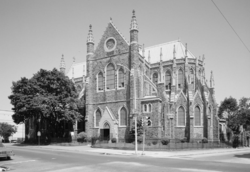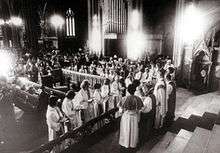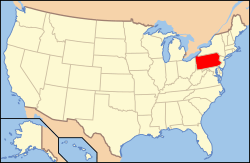Church of the Advocate
The George W. South Memorial Church of the Advocate, also known as the George W. South Memorial Protestant Episcopal Church, is a historic church at 18th and Diamond Street in North Philadelphia, Pennsylvania, USA.
George W. South Memorial Protestant Episcopal Church of the Advocate | |
 | |
   | |
| Location | 18th & Diamond Sts. Philadelphia, Pennsylvania |
|---|---|
| Coordinates | 39°59′9″N 75°9′49″W |
| Built | 1887 |
| Architect | Charles Marquedant Burns; Arthur H. Williams & Sons |
| Architectural style | Gothic Revival |
| NRHP reference No. | 80003620[1] |
| Significant dates | |
| Added to NRHP | February 8, 1980 |
| Designated NHL | June 19, 1996 |
| Designated PHMC | July 29, 1999[2] |

History
The church was built from 1887 to 1897 as a memorial to the merchant and civil leader George W. South. The church was designed by Charles Marquedant Burns (1838 – 1922), a prominent church architect in the late 19th and early 20th century. It was intended to serve as the Episcopal Cathedral of Philadelphia.[3]
On July 29, 1974, the church was the site of the ordination of the Philadelphia Eleven, the first women priests in the Episcopal Church.[4][5]
The church contains a series of 14 murals[6] depicting vignettes of the Black experience in America, including slavery, emancipation, and scenes from the Civil Rights Movement. They were painted between 1973 and 1976 by Philadelphia artist Walter Edmonds[7] The murals can be found primarily in the transepts and aisles of the church. Father Washington commissioned the murals in response to black parishioners who felt that the African-American experience was not validated in the church despite the fact that the majority of the community was African-American. Each of the fourteen murals was painted by either Edmonds or Watson, each of whom has a very different artistic style. Edmonds's[8] pieces are mostly in fiery shades of orange and yellow and depict the violent oppression of blacks in America. Watson,[9] on the other hand, used a cooler palette in his paintings to express sorrow in the black experience and the importance of memorializing this history as a way to find courage for the future.
The church was added to the National Register of Historic Places in 1980, and was designated a National Historic Landmark on June 19, 1996. The landmark designation cited the church as one of the finest examples of Gothic Revival architecture, with a complete set of stained glass windows provided by the English firm Clayton & Bell. It also cited the church's ongoing role in activism for African American civil rights.[10]
The Church of the Advocate serves as host space for Art Sanctuary, a Black art performance program in the heart of the Black community.
See also
References
- "National Register Information System". National Register of Historic Places. National Park Service. January 23, 2007.
- "PHMC Historical Markers". Historical Marker Database. Pennsylvania Historical & Museum Commission. Archived from the original on December 7, 2013. Retrieved December 10, 2013.
- Listing Archived 2011-06-06 at the Wayback Machine as a National Historic Landmark at the National Park Service.
- "Woman in the News: Advocate of Equality, Barbara C. Harris", New York Times, by Peter Steinfels, September 26, 1988.
- Charles V. Willie, "The Priesthood of All Believers: Sermon preached on the occasion of a Service of Ordination..., July 29, 1974" in Betty Bone Schiess, Why Me Lord?: One Woman's Ordination to the Priesthood with Commentary and Complaint (Syracuse, NY: Syracuse University Press, 2003) pp. 145-152
- "Archived copy". Archived from the original on 2002-02-04. Retrieved 2009-12-18.CS1 maint: archived copy as title (link)
- Philadelphia artist Walter Edmonds, 73, died of a heart attack Sunday, June 12, 2011 at Thomas Jefferson University Hospital. In a review of "Biennial 2000: At the Crossroads," at the African American Museum in Philadelphia, Inquirer art critic Edward J. Sozanski wrote that Mr. Edmonds was among those in the show who were prominent enough that their "absence would be conspicuous." Edmonds was well known for his work at the Church of the Advocate in North Philadelphia. From 1973 to 1976 Edmonds and the artist Richard Watson, at the invitation of the Rev. Paul M. Washington, the longtime pastor of that Episcopal congregation, painted 14 murals inside the church. In 2003, an Inquirer reporter wrote that they were still significant because of the "hallucinatory imagery that connects the Bible and the black experience of slavery and uprising - flaming heads and spurting blood, along with heroes ranging from Nat Turner and Harriet Tubman to Malcolm X." The murals were also the centerpiece for "North & Beyond: The Mural Cycle," a 2003 multimedia performance at the church that followed a similar 2002 event there titled "North Called Home." In 2000, The Inquirer reported that the National Endowment for the Arts had given a $10,000 grant to the Perkins Center for the Arts in Moorestown for a public mural in East Camden. Edmonds was "in charge of the community process for the project," the story reported. He painted murals at the West Philadelphia Regional Library in 1989 and at Frankford High School in 2004, among others. The mural at the library was titled Adventures in Reading. In 1996, he was a recipient of the Giverny Terra Fellows Program where he studied French Impressionalists. While he was in Giverny, France, he passionately painted in the gardens of Claude Monet. Mural painting was not his only medium. In 2003, his etchings were in a group show at Artists' House Gallery, on Second Street north of Market Street. Three years earlier, Sozanski had reported that the gallery had staged "a tribute to the centennial of the Philadelphia Orchestra" in a group show by 14 artists with "small etchings of musicians" by Edmonds. In 2002, a report about the annual Open Studios Tour noted that Edmonds had invited the public to his workplace to "view his colorful landscape paintings, prints, and sculpture." Born in Philadelphia, Edmonds graduated from what is now Bok Technical High School in 1956. He attended what is now the University of the Arts in 1962, the Fleisher Art Memorial in 1975, and the Pennsylvania Academy of the Fine Arts in 1992. A 1972 Philadelphia Daily News story reported that at that time he was administrator of the Mantua Halfway House, 428 N. 38th St. The outpatient program there was started four years earlier by the Young Great Society, a neighborhood organization. His resume shows that Edmonds completed murals at the Halfway House, one titled Promise of Tomorrow in 1970 and one titled Struggle for Life in 1973. In the 1960s, he was employed by the City of Philadelphia as a City Surveyor. Obituary - Philadelphia Inquirer, Saturday, June 18, 2011
- "Archived copy". Archived from the original on 2008-07-23. Retrieved 2009-12-18.CS1 maint: archived copy as title (link)
- "Archived copy". Archived from the original on 2008-07-23. Retrieved 2009-12-18.CS1 maint: archived copy as title (link)
- "NHL nomination for Church of the Advocate". National Park Service. Retrieved 2017-03-17.
External links
- Official website

- Listing at Philadelphia Architects and Buildings
- Historic American Buildings Survey (HABS) No. PA-6672, "Church of the Advocate"

